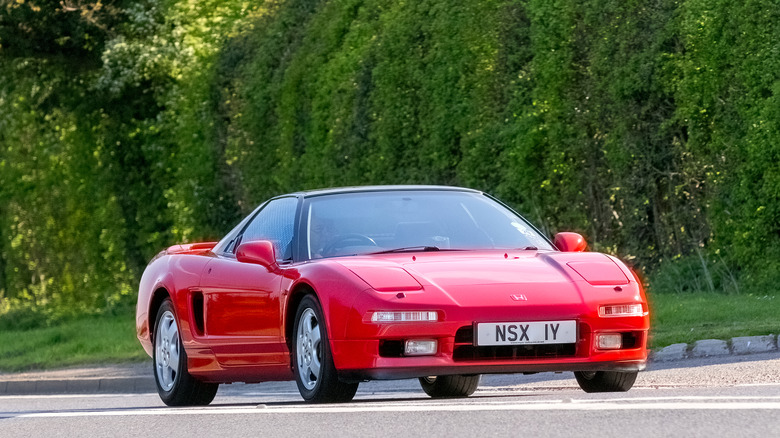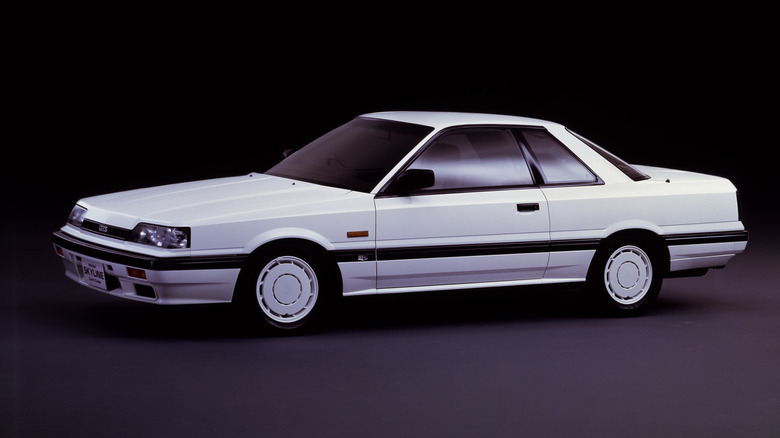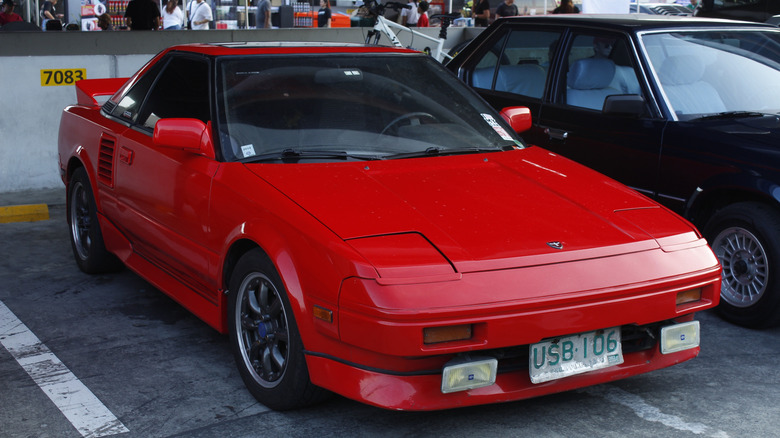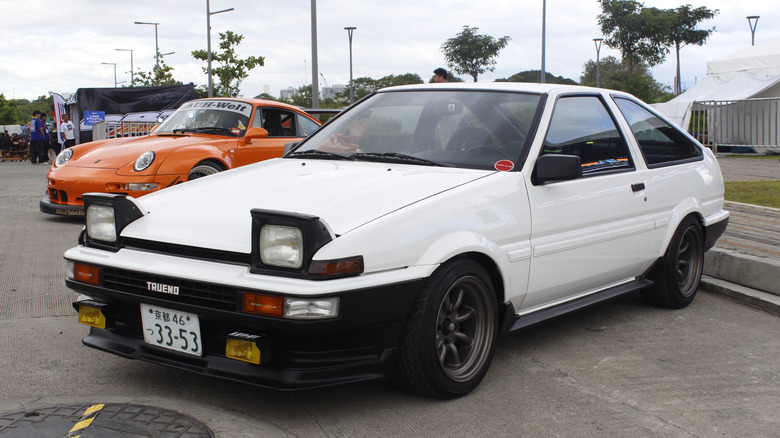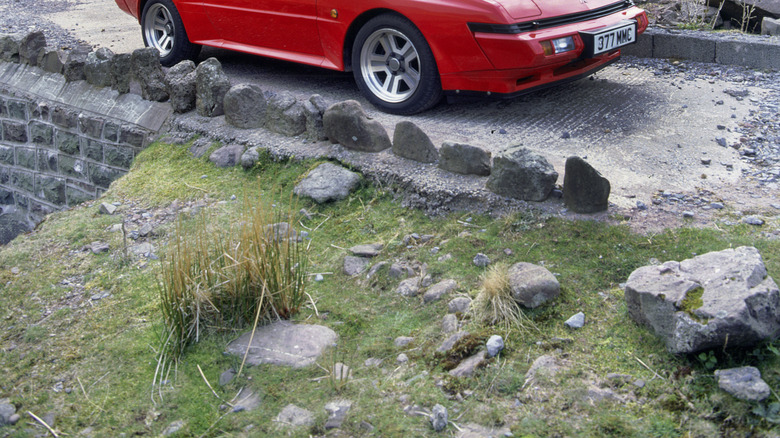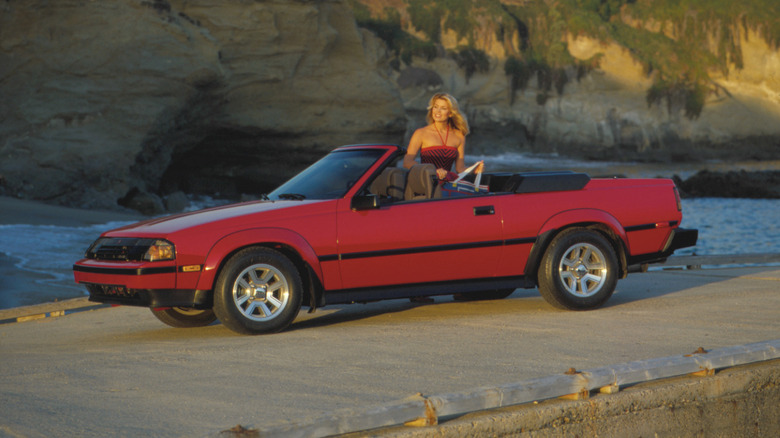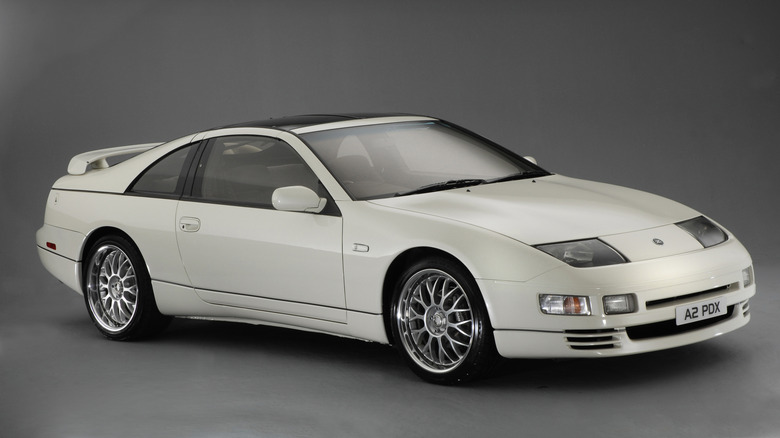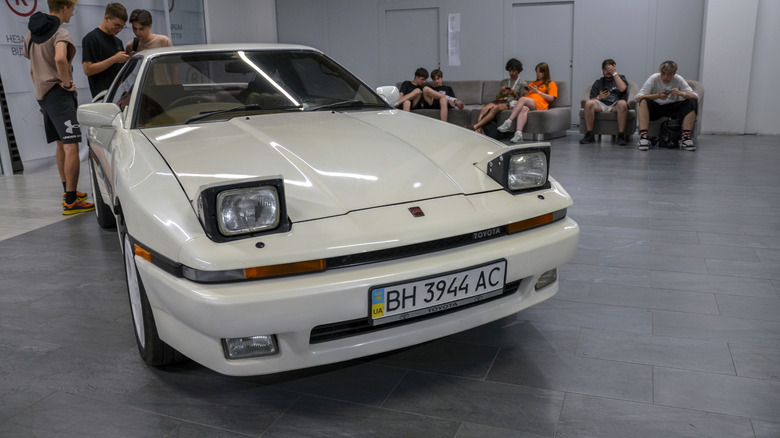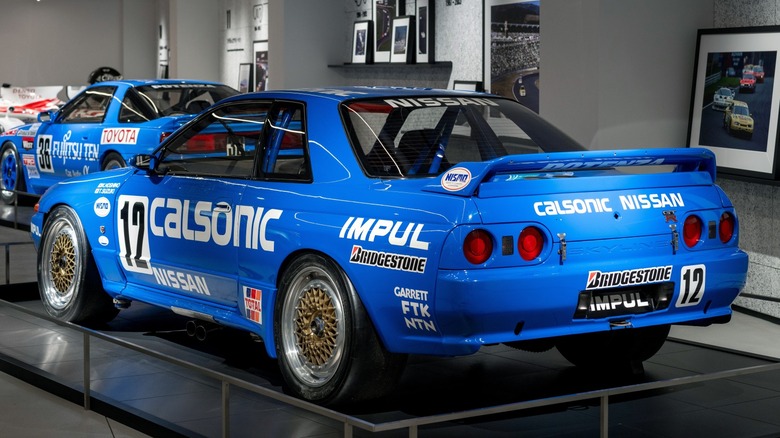10 Iconic JDM Cars Of The 80s, Ranked By Original Price
The 1980s was simultaneously one of the best and one of the worst decades in automotive history. While we Americans busied ourselves making automotive disasters thanks to emissions regulations and the notorious SMOG restrictions, economic crises had Japan's car industry pulling in its belt a few notches, too.
However, rather than settling for making sensibly boxy economy cars, Japanese automakers got clever. Faced with tighter budgets and mounting restrictions, they found workarounds that resulted in some JDM vehicles that were truly ahead of their time — cars that proved they still had soul, even without a washing-machine sized V8.
These cars offered something far more sophisticated: precision engineering wrapped in lightweight bodies that could curve around corners like ballet dancers. If you're wondering, JDM stands for "Japanese Domestic Market" and reflects the intended destination of these cars. Why they ended up on the other side of the planet in such numbers is a story for another day, but to say the least, the greatest JDM cars suddenly made European exotica look overpriced and fragile. With that in mind, here are 10 absolute legends from that golden decade, ranked by what they cost when new.
Nissan Skyline GTS — Multiple Values
We can't possibly have a list of JDM cars and not make a mention of at least one of the many generations of the Nissan Skyline. Introduced in 1986, the GTS variant was intended to be a coupe version, though it later got a four door twin cam variant as well. Nissan had just launched the seventh-generation Nissan Skyline just one year previous, available to order in a whopping 32 different body styles, with an equally impressive (for the time, anyway) six engine options to choose from. After seeing the overwhelmingly positive public response to the R31 Skylines in 1985, Nissan then introduced the twin-cam, two-door sports coupe in 1986, which it called the GTS.
This variant would coincidentally also be the start of a legend — being the first Skyline to get the "red-top" FH20 engine, with the red cam coverings. Pricing varied far too greatly depending on trim, import state, and options at the time, so we can't give you an official price for this one, but you can snag a great example today for under $10,000. Performance for the Skyline was, of course, stellar, with a 0-60 mph time of 7.1 seconds, a 0-100 mph time of 20.8 seconds, and an estimated top speed of 132 mph, making it one of the best affordable sports cars of the time.
Toyota MR2 — $10,999
This next car released in 1984, and went on to become one of Toyota's longest-running cash cows, being in production until as late as 2007 in mainstream markets all around the world. Cars like the Porsche 914 and Lancia Scorpion were a failure, so naturally, Toyota decided to give the small, mid-engined segment a go, and would give the world its answer by way of the SV-3 concept car being unveiled at the 1983 Tokyo Auto Show. The production variant was called the MR2 because it was a Mid-engined, Rear wheel drive, two seater sports car, and did it ever take off. It sold 129,997 units before the turn of the century in the U.S. and Canada alone.
When it was launched, the MR2 made 112 hp and 102 lb-ft of torque from a 1.6-liter inline-four cylinder engine, whilst weighing only 2,300 pounds. In 1988, buyers also got the option to equip their MR2s with a supercharger that bumped the horsepower up significantly, to 145 hp and 140 lb-ft of torque. When new, the Mk1 Toyota MR2 came with a sticker price of $10,999 — equivalent to about $33,000 today — which was okay for what was essentially a store-brand exotic car. It posted performance figures that belied the cost and small engine, with a 0-60 mph time of 8.1 seconds, and a respectable top speed of 124 mph.
Toyota AE86 — $12,000
One of the more affordable JDM cars on our list, the Toyota AE86's common name is simply the internal code specifically referring to the fifth-generation Corolla with a 1.6-liter engine and rear wheel drive. This masterpiece of engineering from Toyota came out in 1983, and was also called the "Hachi-Roku" which literally translated to "eighty six" in Japanese. However, it was only marketed as the Corolla AE86 outside of Japan. Within the country it was sold as either the Toyota Sprinter Trueno or the Toyota Corolla Levin, with Trueno being the Spanish word for thunder and Levin meaning "lightning." In all markets that it was sold in except Europe, the AE86, or Trueno, or Levin — whatever you want to call it — was available as a three-door hatchback or a two-door coupe version, with a GT version coming later.
In terms of pricing, it would cost about $12,000 depending on options in the U.S., though prices differed greatly by country. Now, this isn't to say that the Levin and Sprinter Trueno were the same car, as there were indeed some subtle design differences: for example, the Trueno would have pop-up headlamps, and the Levin had fixed headlamps, but performance wise they posted very similar numbers. It could go from 0-60 mph in 8.3 seconds, and had a top speed of 122 mph, courtesy of its 1.6-liter inline-four engine that made 122 hp and 105 lb-ft of torque.
Subaru XT6 — $16,116
The next car on our list comes from sports car legends Subaru, and was released in 1988 alongside a minor refresh of the regular XT model. The XT6 was given the "6" designation thanks to it coming with a six-cylinder engine that would soon attain hall of fame status, and adding to the legacy of the nameplate, this was Subaru's first flagship dedicated sports car. In the 70s, Subaru had earned a reputation for building economical, well-built cars that would last a lifetime if cared for. In the 1980s, it began eyeing the upmarket sports car segment, resulting in the exceedingly mediocre Subaru XT in 1985.
The XT6 was meant to fix all the problems of the XT, and fix them it did. With a 0-60 mph time of 9.1 seconds and a top speed of 136 mph, the car's 2.7-liter flat-six engine pushed out an impressive 145 hp and 156 lb-ft of torque at 4,000 rpm. This beauty of a power plant could be paired to either a four-speed automatic or a five-speed manual gearbox, though of course, true enthusiasts preferred the feedback of the manual version. When new, a base spec XT6 would run a buyer about $16,116 for the FWD version, equivalent to $44,000 in 2025, adjusted for inflation — not a bad deal for what was essentially a sports car for the road.
Mitsubishi Starion — $17,500
Perhaps a surprising inclusion on this list is the Mitsubishi Starion that was released in 1982 to admittedly subdued fanfare. With that said however, the Starion won the public over in mere weeks, and today it remains one of the most sought-after JDM cars. At launch, it cost a somewhat modest $17,500, which would be $58,800 in 2025, making it a car that a fair number of people could afford, as the median income in the U.S. that year was $23,430, which, adjusted for inflation, would be equal to about $78,700 today. And good condition models are still extremely affordable, even today.
Power for the U.S. version of this poster icon came from a 2.6-liter inline-four engine that happened to be one of the biggest four-cylinders of the time, making 155 hp at 5,500 rpm and 209 lb-ft of torque at 2,500 rpm, while being mated to either a five-speed manual gearbox or a four-speed automatic. Other markets got two variants of a 2.0-liter engine instead of the 2.6-liter one that we got, with one version making 170 hp with 181 lb-ft of torque and the other version making 180 hp and 214 lb-ft of torque. An interesting fact about this car is that it is known in enthusiast circles as the "StarQuest", because from 1984 to 1989, the Starion was sold in the U.S. by Chrysler who marketed it as the Chrysler Conquest.
Toyota Celica GTS — $17,669
One of several Celica variants released in the 1980s, the Toyota Celica GT-S is among the most unusual JDM vehicles ever made. The parent model Celica — especially the Celica GT4 — was a dominant force in rallying, and carved a name for itself in endurance racing as well, but when the GT-S arrived stateside, the cabriolet market in the U.S. was at one of its lowest points. Emissions regulations and SMOG compliance had killed the sporty convertible as we knew it, and the dismal selection of options that we did have back home were all conversions from coupe variants. But then we got the Toyota Celica GT-S convertible, making 116 hp and 140 lb-ft of torque from an eight-valve, 2.4-liter inline-four engine.
We should mention that initially, the Celica was sold as a coupe and liftback model only, but when Toyota saw the demand, the convertible version was introduced for the U.S. only. Additionally, the 1995 model year was the last Celica variant that came with RWD, because in 1986 the Celica would switch to FWD alongside a redesign, and it would remain an FWD car until discontinuation in 2006. When new, it had a starting price of $17,669, which was (a lot) more than the coupe's $11,199 and the liftback's $11,549. The price also made it more expensive than the competing Nissan 300ZX, which came in at around $17,199.
Nissan Z31 (300ZX) — $18,699
This is the kind of car that comes about when Japan decides it wants a share of the muscle car market. The Nissan Z31 was a continuation of the 280Z and 240Z of 1975 and 1969 respectively, and it had some pretty big shoes to fill. It was meant to be a significant upgrade to the Datsun Fairlady Z, and was also one of the cars used in the transition from Datsun to Nissan. When it first came to market in 1984, buyers could choose between a standard four-cylinder engine that was turbocharged, or a bigger, more powerful V6 unit.
You might think, given its fame and love amongst the car community, that the 300ZX was a long-running Nissan model. In truth it was only on sale for 13 years — from 1984 to 1996 — though in Japan you could buy a new one until 2000. Performance figures were acceptable to a market that wanted sportiness alongside good economy, with a 0-60 mph time of 7.3 seconds, a 0-100 mph time of 20.1 seconds, and an estimated top speed of 134 mph — all in a package that didn't require a second mortgage. Prices for the top option 300ZX started at $18,699 when new in 1984, climbing to $37,844 by the time order books closed in 1996.
Supra A70 (Mk3) — $26,000
The story of the Toyota Supra is one worth reading, starting as a glorified Celica and going on to become one of the most coveted collector cars in America. When it comes up in conversation, many people will reference the Mk4 Supra that was one of the cars driven by the character Brian O'Conner in the "Fast & Furious" franchise. The Mk4 was produced between 1993 and 1998, becoming a widely beloved model and relegating the Mk3 to some dusty corners of drivers' memories. However, we're here to tell you that the Mk3 Supra with the A70 model code is one of the most underrated and iconic JDM cars, not just of the 1980s, but of all time.
With its wedge design, brand-spanking-new RWD chassis, and beefier six-cylinder powerplant, the Mk3 Supra also marked the point in time that Toyota made it a model in itself. Up until the previous generation Mk2, the Supra had simply been a Celica-based performance model, but with the Mk3, it became its own nameplate — one of the best decisions that Toyota ever made. In the U.S., it was powered by a 3.0-liter inline-six engine that produced 200 hp and 196 lb-ft of torque, that gave the Mk3 Supra a 0-60 mph time of 6.9 seconds, and a top speed of 146 mph — not bad for a car that cost around $26,000 when new.
Nissan Skyline R32 — $30,000
The word "Skyline" encompasses a far greater range of cars to Japanese drivers than it does to us — we're mostly familiar with just the R34 and R35 Skylines. However, ask any Japanese gearhead, and they'll tell you that the real kings of the hill were the seventh generation R31 and eighth-generation R32 versions, produced from 1985 and 1989 respectively. The seventh generation was special because it reintroduced a six-cylinder power unit — one of those JDM engines with way more power than you would think — and the eighth generation was important because it brought back the GTR spec after a 16-year absence.
When the R32 platform was being researched, Nissan secretly designated a platform called "GT-X" to test the performance and viability of its chassis for Group A racing — and it was this GT-X platform that would later respawn several versions of the GTR. Performance figures were amazing for the year, with a 0-60 mph time of 4.8 seconds and a top speed of 146 mph. To make the heavy platform competitive, Nissan upped the engine displacement, and the rest was history. When new, an R32 Skyline GTR would have run you between $30,000 to $50,000, equivalent to $71,000 today, but you got a lot of car for the price. Today, prices don't fall much below $45,000, and that's just for the base model.
Honda NSX — $60,000
The next car on our list is one of Japan's greatest creations — an automotive god — the Honda NSX. We include it on our list of iconic JDM cars of the 80s because it was unveiled in 1989 at the Chicago Motor Show, even though deliveries only started in 1990. The story of the NSX actually began in 1984, when the Wako research and development center began a shift from F/F (front engine, FWD) cars to UMD (underfloor, mid-engined) versions, believing that this would give Honda more flexibility with frame design. Though the project was initially shelved because of tech constraints, it did eventually result in the NSX.
It came with a never-before-seen all-aluminum monocoque body, power windows, automatic AC, traction control, and ABS. In 1989, Honda got Ayrton Senna himself to test the car at Suzuka, and would later test it extensively at the Nürburgring in Germany. The NSX produced 252 hp and 210 lb-ft of torque from a 3.0-liter V6 that managed to rocket it from 0-60 mph in 5.9 seconds — faster than the Ferrari 328's time. When new, the NSX had a base price of $60,000, which, adjusted for inflation, equates to about $141,527 today — a price that was well worth it at the time. And, like many of the cars on our list, this particular Japanese icon turned out to be a solid investment, with even mediocre condition units selling for north of $80,000 dollars on the used market today.
